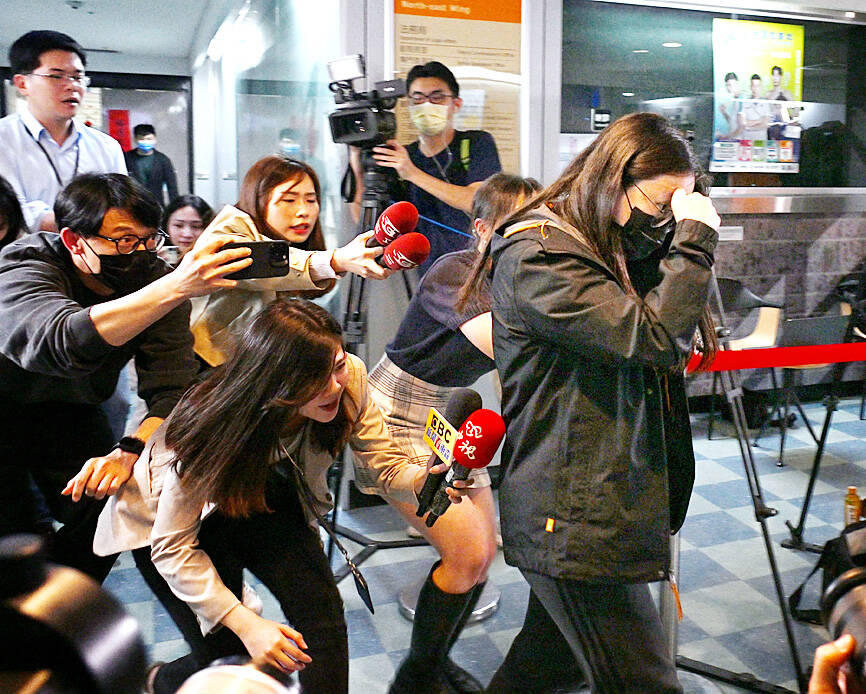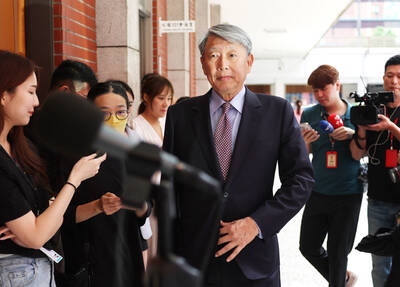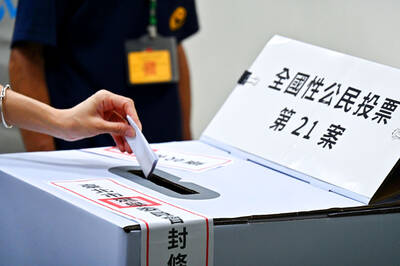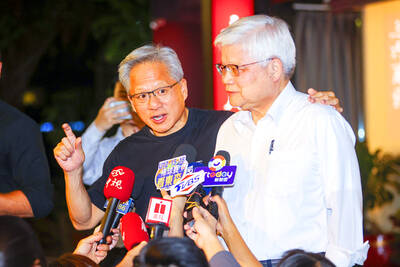An autopsy discovered bongkrekic acid in a specimen collected from a person who died from food poisoning after dining at the Malaysian restaurant chain Polam Kopitiam, the Ministry of Health and Welfare said at a news conference last night.
It was the first time bongkrekic acid was detected in Taiwan, Deputy Minister of Health and Welfare Victor Wang (王必勝) said.
The testing conducted by forensic specialists at National Taiwan University was facilitated after a hospital voluntarily offered standard samples it had in stock that are required to test for bongkrekic acid, he said.

Photo: Fang Pin-chao, Taipei Times
Wang told the news conference that testing would continue despite the major discovery.
“This is not the conclusion of the case. Prosecutors would make that judgement after examining all evidence. Aside from the specimens collected from deceased patients, we will also continue testing specimens collected from patients who are being treated at hospitals,” Wang said.
Tests would also be carried out on ingredients collected from restaurants and rice noodle suppliers, he said.
Wang said that the preliminary results were generally in sync with the conclusion reached at an expert meeting on Wednesday, where they identified bongkrekic acid as the likely cause of the food poisoning.
As of yesterday afternoon, 18 people had been reported as experiencing food poisoning after eating rice noodles at Polam Kopitiam in Taipei’s Xinyi District (信義) from Tuesday last week to Sunday, data from the Centers for Disease Control showed.
Two have died, while six are still being treated in hospitals and 10 are recovering at home, data showed.
The investigation would focus on whether the outbreak was caused by endogenous toxins from food ingredients, or toxins added to the food by people, Minister of Health and Welfare Hsueh Jui-yuan (薛瑞元) told reporters yesterday before attending a meeting of the legislature’s Social Welfare and Environmental Hygiene Committee in Taipei.
“There are three types of food poisoning: The first type is caused by microorganisms, such as norovirus. The second type is caused by endogenous toxins from food ingredients, such as bongkrekic acid, while the third type is caused by toxins added to food by people,” Hsueh said.
Experts at the meeting on Wednesday night said that the case is unlikely to have been caused by microorganisms, Hsueh said, adding that the investigation would focus on whether the case falls under the second or third types.
Prosecutors are investigating whether the poisoning was fabricated, he said.
Asked whether local health officials were slow in reacting to the non-typical food poisoning case, Hsueh said they all followed standard procedures to test patients as a majority of food poisoning cases are caused by microorganisms.
“They eventually realized this was not a typical food poisoning case when more patients were brought in with symptoms progressing from vomiting to liver or kidney failure within just 12 hours. We were also on alert and quickly invited experts to investigate the cause,” Hsueh said.
Wang also said at a news conference after a weekly Cabinet meeting that, unlike other collective food poisoning cases, where multiple people consumed food together at the same time and showed symptoms afterward, patients, in this case, dined at the restaurant at different times.
One could only determine if they were poisoned by retrospectively tracing their whereabouts before they showed symptoms, Wang said.
Meanwhile, the legal representative of Polam Kopitiam as well as a branch manager and chef were banned from leaving the country by prosecutors yesterday for their “suspected involvement” in what is believed to be a food poisoning outbreak.
Additional reporting by CNA

CHIPMAKING INVESTMENT: J.W. Kuo told legislators that Department of Investment Review approval would be needed were Washington to seek a TSMC board seat Minister of Economic Affairs J.W. Kuo (郭智輝) yesterday said he received information about a possible US government investment in Taiwan Semiconductor Manufacturing Co (TSMC, 台積電) and an assessment of the possible effect on the firm requires further discussion. If the US were to invest in TSMC, the plan would need to be reviewed by the Department of Investment Review, Kuo told reporters ahead of a hearing of the legislature’s Economics Committee. Kuo’s remarks came after US Secretary of Commerce Howard Lutnick on Tuesday said that the US government is looking into the federal government taking equity stakes in computer chip manufacturers that

POWER PLANT POLL: The TPP said the number of ‘yes’ votes showed that the energy policy should be corrected, and the KMT said the result was a win for the people’s voice The government does not rule out advanced nuclear energy generation if it meets the government’s three prerequisites, President William Lai (賴清德) said last night after the number of votes in favor of restarting a nuclear power plant outnumbered the “no” votes in a referendum yesterday. The referendum failed to pass, despite getting more “yes” votes, as the Referendum Act (公民投票法) states that the vote would only pass if the votes in favor account for more than one-fourth of the total number of eligible voters and outnumber the opposing votes. Yesterday’s referendum question was: “Do you agree that the Ma-anshan Nuclear Power Plant

Chinese Nationalist Party (KMT) lawmakers have declared they survived recall votes to remove them from office today, although official results are still pending as the vote counting continues. Although final tallies from the Central Election Commission (CEC) are still pending, preliminary results indicate that the recall campaigns against all seven KMT lawmakers have fallen short. As of 6:10 pm, Taichung Legislators Yen Kuan-heng (顏寬恒) and Yang Chiung-ying (楊瓊瓔), Hsinchu County Legislator Lin Szu-ming (林思銘), Nantou County Legislator Ma Wen-chun (馬文君) and New Taipei City Legislator Lo Ming-tsai (羅明才) had all announced they

Nvidia Corp CEO Jensen Huang (黃仁勳) yesterday visited Taiwan Semiconductor Manufacturing Co (TSMC, 台積電), as the chipmaker prepares for volume production of Nvidia’s next-generation artificial intelligence (AI) chips. It was Huang’s third trip to Taiwan this year, indicating that Nvidia’s supply chain is deeply connected to Taiwan. Its partners also include packager Siliconware Precision Industries Co (矽品精密) and server makers Hon Hai Precision Industry Co (鴻海精密) and Quanta Computer Inc (廣達). “My main purpose is to visit TSMC,” Huang said yesterday. “As you know, we have next-generation architecture called Rubin. Rubin is very advanced. We have now taped out six brand new